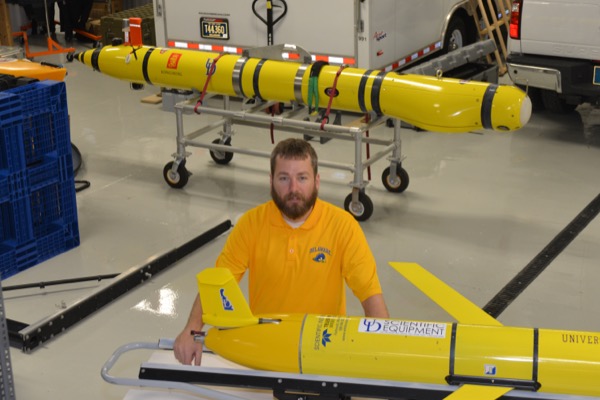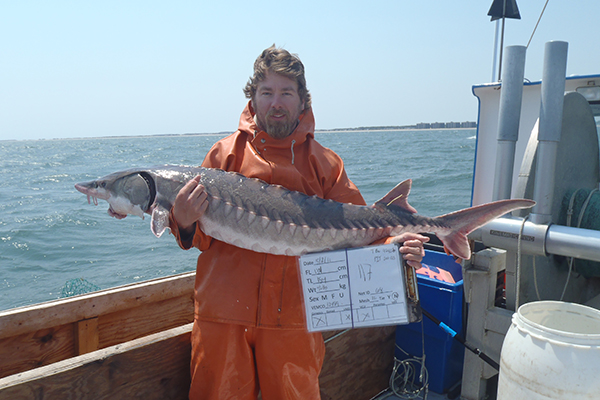Safeguarding sturgeon
Satellite measurements of ocean color, temperature help researchers predict sturgeon locations
1:23 p.m., Feb. 3, 2016--Researchers at the University of Delaware are one step closer to developing an online map that would help Mid-Atlantic fishermen avoid catching Atlantic sturgeon.
The research team, led by Matthew J. Oliver, Patricia and Charles Robertson Professor of Marine Science and Policy, found they could make useful predictions about sturgeon locations using satellite measurements of ocean color and temperature. They reported their findings Feb. 3 in the journal Methods in Ecology and Evolution.
Research Stories
Chronic wounds
Prof. Heck's legacy
The researchers believe this to be an important step toward helping both fishermen and the vulnerable fish. If they can reliably predict where sturgeon or other “species of concern” are congregating or migrating, they can relay this information to fishermen through a daily fishing forecast, similar to a weather forecast.
Fishermen sometimes accidentally catch sturgeon while targeting other species. Known as bycatch, this occurrence affects the species and can impact a fisherman’s allowable catch of other fish.
“This gets us closer to using habitat preferences as a guide to help fishermen be successful while reducing harm to non-target species,” said the paper's lead author, Matthew Breece, a doctoral candidate in UD’s School of Marine Science and Policy, which is housed in the College of Earth, Ocean, and Environment. “It’s surprisingly accurate, and we see a lot of options for making it even better.”
Sturgeon select seascapes
Where exactly sturgeon swim in the marine environment is a big unknown in the coastal ocean. On land, researchers use features of the landscape to predict where a species will be found. The UD team set out to do something similar using “seascapes,” or zones of the ocean that can be readily identified.
The research team studied the Delaware Bay and nearby coastal waters in Delaware, Maryland and New Jersey. By analyzing 10 years of satellite data, the researchers classified adjoining ocean areas with similar color and temperature. Their analysis identified six seascapes that form strips roughly parallel to the coast and can be anywhere from one mile to 20 miles wide. Local currents, tides and winds affect the seascape’s location, which can vary as much as 10 or more miles in a single day.
The researchers combined these time-dependent seascape maps with locations of individual sturgeon. They determined locations using tags implanted in sturgeon that can be detected by a set of 94 stationary acoustic sensors arrayed along the coast.
According to Breece, the maps show that sturgeon seem to prefer a narrow corridor identified as Seascape E, which generally sits near the coast but sometimes expands into open waters south of the Delaware Bay and Atlantic Ocean. Half of the sturgeon detections were in that seascape, even though it covered only 35 percent of the available area, indicating selection for environmental factors over geography.
To test this hypothesis, the team deployed an autonomous underwater vehicle called a glider in 2013. The glider was equipped with telemetry detectors that enabled the researchers to actively look for the tagged sturgeon.
“We expected to see the sturgeon closer to shore. For 7-10 days the glider did not detect any sturgeon, despite being in regions of the water where we had seen sturgeon in the past,” said Breece. “I actually thought the glider might be broken or the sensors might be damaged.”
As soon as the glider arrived in Seascape E, however, it started detecting tagged sturgeon — 62 of them actually — some from as far away as South Carolina.
“That’s when it sunk in that the sturgeon were cuing in on this particular seascape, even though it moves around,” Breece said.
The scientists aren’t sure why the sturgeon prefer this seascape. Sturgeon are typically bottom feeders, eliminating the idea that they may be chasing prey that is moving with the seascapes.
“It could be a foraging preference, or it could be that the seascape acts like a ‘turn signal,’ telling the sturgeon that it’s time to turn toward the Delaware River and return home to spawn. We don’t know,” Breece said.
Future research will focus on characterizing the water properties in the preferred seascape and exploring whether other cues in the water can be read from satellite or oceanographic data.
“We still have work to do before this is ready for fishermen,” Oliver said. “But this gives us the scientific basis to build something really useful and to expand from sturgeon to other species.”
Co-authors on the paper, titled “Dynamic Seascapes Predict the Marine Occurrence of an Endangered Species: Atlantic Sturgeon Acipenser oxyrinchus oxyrinchus,” include Oliver, Dewayne Fox (Delaware State University), Keith Dunton and Mike Frisk (Stony Brook University), and Adrian Jordaan (University of Massachusetts Amherst).
The research was funded in part by the National Oceanic and Atmospheric Administration, the Mid-Atlantic Coastal Ocean Observing System (MARACOOS), and the Lenfest Ocean Program.
Video by Leah Dodd
Photo of Matthew Breece with research equipment by Lisa Tossey
Photo of Matthew Breece with sturgeon courtesy of Delaware State University, NMFS Permit No. 16507-01












